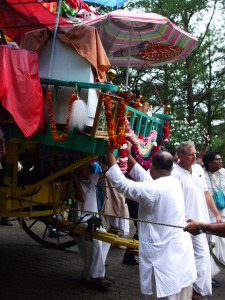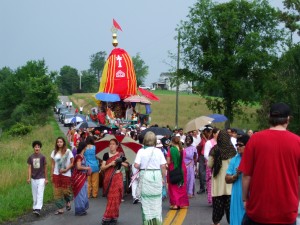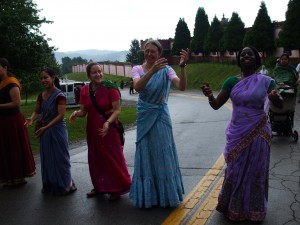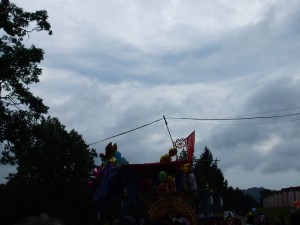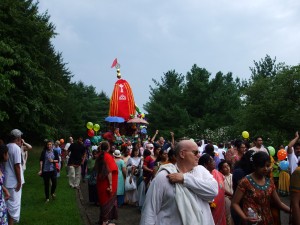Many site visitors have asked for transcriptions of the audio, especially the QAs. We have a team of volunteers who are working diligently at it. To accelerate the transcription, a devotee Ronak Prabhu has offered to sponsor the transcription, providing Rs 250 for every hour of transcription. This may involve about 7-8 QAs for transcription as the average length of an answer is usually between 5 to 10 mins. Those interested can write to Vaibhava Prabhu at vaibhav.sharma@zensar.in
Transcription service announcement
Matter, not spirit, is formless
→ The Spiritual Scientist
The Bhagavad-gita (2.20) clearly says that after the destruction of the material body the living entity is not annihilated, nor does he lose his identity. The identity of the living entity is never impersonal or formless; on the contrary, it is the material dress that is formless and that takes a shape according to the form of the indestructible person.
To end our forgetfulness, let’s first commit to end our forgetfulness of our forgetfulness (08.08)
→ The Spiritual Scientist
We may sometimes become discouraged in our spiritual life: “I keep forgetting Krishna repeatedly even after practicing devotional service for so long. Is my practice of any use?”
Yes, it definitely is. Because it ends our forgetfulness of our forgetfulness. And that’s the only way to progress towards ending our forgetfulness.
When we drive a car, by default it tends to go off course unless we get it back on course. The same applies to our spiritual journey. The body-mind mechanism is like a vehicle for us souls. We can use it to return to Krishna by keeping ourselves on the track of devotional service. But this material mechanism, especially the mind, has default tendencies to gravitate towards worldly pleasures. During our journey on the track of devotional service, these tendencies push us off course. We cannot wish these tendencies away by any waving of a magic wand.
The only way to get rid of them is by steady, sustained rejection whenever they appear. Practically, this means that we get ourselves back on course, no matter how many times we find ourselves pushed off course. The Bhagavad-gita (08.08) assures us that if we practice bringing the mind back under control whenever it wanders, we will eventually attain perfection. When we commit ourselves to daily diligent practice of devotional service, we ensure that we commit to making course corrections regularly.
Our meditation and study first remind us that we have forgotten and then they remind us of what we have forgotten. The more we enthusiastically cultivate conscious remembrance of Krishna, the more our attraction to him deepens. This increases our remembrance of him at other times too till finally our forgetfulness dies. And thereby we live forever in Krishna’s love in this world and the next.
***
8.8 - He who meditates on Me as the Supreme Personality of Godhead, his mind constantly engaged in remembering Me, undeviated from the path, he, O Partha, is sure to reach Me.
Can we use the word “our spiritual glory” when actually we are meant to be humble servants in spiritual life?
→ The Spiritual Scientist
Is obesity a medical problem or a behavioral problem?
→ The Spiritual Scientist
If we are in a service that doesn’t inspire us how long can we continue in that service?
→ The Spiritual Scientist
SB 8.3.9 Let Krishna do his ascharya karma in the heart
→ The Spiritual Scientist
Can devotees use positive thinking techniques like visualizations and affirmations?
→ The Spiritual Scientist
Sunday, July 21st, 2013
→ The Walking Monk
Calgary, Alberta
Sleep was not going to be an easy task last evening. It became a blessing in disguise. I pulled myself off the mattress and ambled my way outside at the east end of Calgary when I opened my eyes to a marvelous display of the northern lights – explosions of light energy flashing about against the sky’s backdrop. It’s nature’s exhibitions like this that puts one in awe, and perhaps even reverence towards the Maker or Creator.
I had trekked along on a bike trail that looped when I spotted this wonder by nature. The trail ended up at a retail strip area where I came upon a nightclub which pulsated some rave music. Through a window I could see young folks gyrating to the gutsy thump of the music as the lights flashed with diverse colours meant to heighten the ecstasy of it all.
Little did the dancers know that something much more exciting was happening from above. When I actually passed by the main door of the club, a crowd was ‘hanging out’ on the street level mildly intoxicated. They could also not see the wondrous display from heaven. For them the center of life was encircled around the nightclub. At night time street lights naturally blur or obscure what is in the sky, and that includes the northern lights which I understand is a play of the sun’s rays within an electromagnetic field in the ether.
Hey, the club dancers were really missing something and I guess in a way I felt for them. What seemed to be more important to them is finding themselves within some conjugal relationship. Okay, so be it. Meanwhile, my connection with nature’s light show and its source became more than a beautiful momentary reality, it’s something to be appreciated.
10 KM
Monday, July 22nd, 2013
→ The Walking Monk
Hamilton, Ontario
Our short little bhakti road show in the prairies had been completed and we had flown back to Toronto on the previous day. Now, a second tour began, but this time it’s the replacement of the annual youth bus tour that I’ve been on for the last several summers. Kapil, a young bank employee from Alberta came to be chauffer and coordinator to a 12 seater van for a fun tour through Ontario and Quebec. We filled the seats with what I consider to be future leaders for our spiritual mission. I’ll be there for a week as well as Kapil whom we refer to affectionately as Captain Kapil or Cap Kap for short.
My time with Cap Kap and passengers is an investment for the future. Let these young folks have a good experience, fun and discipline mixed together in a spiritual environment. We have two boys from Florida, three girls from Montreal and four boys from Ontario. This is an opportunity for a younger set to get to know a monk more, and me them.
We took to a speed boat along with Korean tourists in the Niagara River through class 5 waves. We took to viewing the falls in full admiration of them. We finally finished with a rich meal at the home of Giri Jadhava, a dear friend who was my captain for travelling on the sankirtan mission in the early 70s. We all cooled down in a swimming pool and he and I reminisced about our days on the road including an amiable encounter with the legendary Vishnujan Swami, a pioneer amongst Krishna monks when we stopped in Baltimore, that was sweet.
Our crew is musical and so we have already begun to take full advantage of their gifted natures by encouraging kirtan, a panacea for the age.
Let there be mantra power that endures throughout the generations.
5 KM
Sunday, July 21st, 2013
→ The Walking Monk
Calgary, Alberta
Sleep was not going to be an easy task last evening. It became a blessing in disguise. I pulled myself off the mattress and ambled my way outside at the east end of Calgary when I opened my eyes to a marvelous display of the northern lights – explosions of light energy flashing about against the sky’s backdrop. It’s nature’s exhibitions like this that puts one in awe, and perhaps even reverence towards the Maker or Creator.
I had trekked along on a bike trail that looped when I spotted this wonder by nature. The trail ended up at a retail strip area where I came upon a nightclub which pulsated some rave music. Through a window I could see young folks gyrating to the gutsy thump of the music as the lights flashed with diverse colours meant to heighten the ecstasy of it all.
Little did the dancers know that something much more exciting was happening from above. When I actually passed by the main door of the club, a crowd was ‘hanging out’ on the street level mildly intoxicated. They could also not see the wondrous display from heaven. For them the center of life was encircled around the nightclub. At night time street lights naturally blur or obscure what is in the sky, and that includes the northern lights which I understand is a play of the sun’s rays within an electromagnetic field in the ether.
Hey, the club dancers were really missing something and I guess in a way I felt for them. What seemed to be more important to them is finding themselves within some conjugal relationship. Okay, so be it. Meanwhile, my connection with nature’s light show and its source became more than a beautiful momentary reality, it’s something to be appreciated.
10 KM
Monday, July 22nd, 2013
→ The Walking Monk
Hamilton, Ontario
Our short little bhakti road show in the prairies had been completed and we had flown back to Toronto on the previous day. Now, a second tour began, but this time it’s the replacement of the annual youth bus tour that I’ve been on for the last several summers. Kapil, a young bank employee from Alberta came to be chauffer and coordinator to a 12 seater van for a fun tour through Ontario and Quebec. We filled the seats with what I consider to be future leaders for our spiritual mission. I’ll be there for a week as well as Kapil whom we refer to affectionately as Captain Kapil or Cap Kap for short.
My time with Cap Kap and passengers is an investment for the future. Let these young folks have a good experience, fun and discipline mixed together in a spiritual environment. We have two boys from Florida, three girls from Montreal and four boys from Ontario. This is an opportunity for a younger set to get to know a monk more, and me them.
We took to a speed boat along with Korean tourists in the Niagara River through class 5 waves. We took to viewing the falls in full admiration of them. We finally finished with a rich meal at the home of Giri Jadhava, a dear friend who was my captain for travelling on the sankirtan mission in the early 70s. We all cooled down in a swimming pool and he and I reminisced about our days on the road including an amiable encounter with the legendary Vishnujan Swami, a pioneer amongst Krishna monks when we stopped in Baltimore, that was sweet.
Our crew is musical and so we have already begun to take full advantage of their gifted natures by encouraging kirtan, a panacea for the age.
Let there be mantra power that endures throughout the generations.
5 KM
BG 5.20B Q&A’s “Oh Spirulina Save Me” – 7/16/2013 – Video
→ Prahladananda Swami
A prayer from the spiritual master
→ KKS Blog
(Kadamba Kanana Swami, 12 July 2013, Fruska Gouranga, Serbia, Initiation lecture)
 We have received the (holy) name a long time ago, right? The maha mantra has been with us for a long time. Still it is said that at the time of initiation, the spiritual master is giving us the harinama. And why is that?
We have received the (holy) name a long time ago, right? The maha mantra has been with us for a long time. Still it is said that at the time of initiation, the spiritual master is giving us the harinama. And why is that?
You could sort of say it’s something like a birthday and you get the gift, open the box and then say that you already got that, “Gosh, I’m getting the harinama but I’ve got that years ago.”
But no, it is not like that. Actually, what is there now is that the spiritual master has rendered service to Krsna and with that service, he has purchased the mercy of Krsna. At the time of initiation, the spiritual master gives us the holy name along with his prayers to Krsna. He prays on our behalf to Krsna and says, “My dear Lord, please bestow your mercy upon this devotee.”
In this way, when we go before Krsna, we are not alone. We are not just judged on our own performance but we go with our spiritual master who has credit with Krsna so then, Krsna is inclined. Therefore, it is very important to have that prayer. The spiritual master’s prayer is not a one-time prayer, it is an ongoing prayer.
It stays with us throughout our spiritual life and at the end of our life, when we come before Krsna, are we going back or not? The big question, are we making it or not? The prayer of the spiritual master puts weight on the scale, more weight even than our own.
Therefore we say that more important in our spiritual life are the blessings from the spiritual master, the prayer from the spiritual master. That is the most powerful factor, therefore it is important to receive the harinama in this way!
A prayer from the spiritual master
→ KKS Blog
(Kadamba Kanana Swami, 12 July 2013, Fruska Gouranga, Serbia, Initiation lecture)
 We have received the (holy) name a long time ago, right? The maha mantra has been with us for a long time. Still it is said that at the time of initiation, the spiritual master is giving us the harinama. And why is that?
We have received the (holy) name a long time ago, right? The maha mantra has been with us for a long time. Still it is said that at the time of initiation, the spiritual master is giving us the harinama. And why is that?
You could sort of say it’s something like a birthday and you get the gift, open the box and then say that you already got that, “Gosh, I’m getting the harinama but I’ve got that years ago.”
But no, it is not like that. Actually, what is there now is that the spiritual master has rendered service to Krsna and with that service, he has purchased the mercy of Krsna. At the time of initiation, the spiritual master gives us the holy name along with his prayers to Krsna. He prays on our behalf to Krsna and says, “My dear Lord, please bestow your mercy upon this devotee.”
In this way, when we go before Krsna, we are not alone. We are not just judged on our own performance but we go with our spiritual master who has credit with Krsna so then, Krsna is inclined. Therefore, it is very important to have that prayer. The spiritual master’s prayer is not a one-time prayer, it is an ongoing prayer.
It stays with us throughout our spiritual life and at the end of our life, when we come before Krsna, are we going back or not? The big question, are we making it or not? The prayer of the spiritual master puts weight on the scale, more weight even than our own.
Therefore we say that more important in our spiritual life are the blessings from the spiritual master, the prayer from the spiritual master. That is the most powerful factor, therefore it is important to receive the harinama in this way!
Lecture – BG 5.20A Tasting Krishna With Covered Senses – 7/16/2013 – Video
→ Prahladananda Swami
Building Trust Within ISKCON
→ Gita Coaching
Building Trust Within ISKCON
→ GITA COACHING
The following are a selection of pictures from the ceremony this Sunday in which family and friends placed my mother’s ashes in the rose garden she had sponsored for Radha-Syama
→ SivaramaSwami.com
to question
→ everyday gita
In order to clarify doubt and truly understand something, two things are required:
One needs to inquire from the right person.
It's a two way street, although a strong case can be made that most of the responsibility falls on the one who is posing the question. That's because they are the ones who:
1) Have to formulate the appropriate question or else they might not get the answer they need.
2) Have the free will to choose (and accept) the person to get answers from.
Let's use a real life example to understand that a bit better. If you've ever been to a foreign country, you might have first hand experience of trying to get to a destination and having no clue where to go. In stopping someone on the street, the first question you might ask is not how to get to x, y, z destination but... "Are you from here?"
That question is an important one as it helps you (the tourist) to find out if you're asking a reputable source (i.e. one who is qualified to answer). Well...at least in my experience, it may help but doesn't necessarily guarantee that you will get the directions you require!
But that qualifying question is an important one. It's easy to get answers to questions...
The difficulty lies in finding the right individual who is actually authorized to answer your question.
Krsna has already established himself as the appropriate person to teach the science of bhakti as described in Verse 4.1. Here, Arjuna is teaching all of us the art of questioning. He has heard Krsna out but still has a doubt and so he asks Krsna to clarify it.
This is where the subtleties of bhakti are revealed. After finding the right guide/teacher and formulating the appropriate question/s the most important thing is the attitude behind the questioning. Is it one of genuine curiosity and inquiry or one of arrogance? It's this attitude that actually determines how much knowledge is imparted from the bhakti yogi to the student.
These are three elements to perfecting the art of questioning - finding the right teacher, asking the right question and checking to see what your attitude is when asking it. Try them out and see how it works for you!
to question
→ everyday gita
In order to clarify doubt and truly understand something, two things are required:
One needs to inquire from the right person.
It's a two way street, although a strong case can be made that most of the responsibility falls on the one who is posing the question. That's because they are the ones who:
1) Have to formulate the appropriate question or else they might not get the answer they need.
2) Have the free will to choose (and accept) the person to get answers from.
Let's use a real life example to understand that a bit better. If you've ever been to a foreign country, you might have first hand experience of trying to get to a destination and having no clue where to go. In stopping someone on the street, the first question you might ask is not how to get to x, y, z destination but... "Are you from here?"
That question is an important one as it helps you (the tourist) to find out if you're asking a reputable source (i.e. one who is qualified to answer). Well...at least in my experience, it may help but doesn't necessarily guarantee that you will get the directions you require!
But that qualifying question is an important one. It's easy to get answers to questions...
The difficulty lies in finding the right individual who is actually authorized to answer your question.
Krsna has already established himself as the appropriate person to teach the science of bhakti as described in Verse 4.1. Here, Arjuna is teaching all of us the art of questioning. He has heard Krsna out but still has a doubt and so he asks Krsna to clarify it.
This is where the subtleties of bhakti are revealed. After finding the right guide/teacher and formulating the appropriate question/s the most important thing is the attitude behind the questioning. Is it one of genuine curiosity and inquiry or one of arrogance? It's this attitude that actually determines how much knowledge is imparted from the bhakti yogi to the student.
These are three elements to perfecting the art of questioning - finding the right teacher, asking the right question and checking to see what your attitude is when asking it. Try them out and see how it works for you!
Gopinath’s Kids Camp – August 24, 2013
→ The Toronto Hare Krishna Blog!
 Imagine a day full of games, laughter, delicious prasadam, chance to make new friends and especially, NO PARENTS! ISKCON Toronto is providing just that and more for the younger members of our community with the 6th Annual Gopinath's Kids Camp!
Imagine a day full of games, laughter, delicious prasadam, chance to make new friends and especially, NO PARENTS! ISKCON Toronto is providing just that and more for the younger members of our community with the 6th Annual Gopinath's Kids Camp!This year, the 5th Annual Gopinath's Kids Camp will be held on Saturday, August 24th from 8:30am-6:00pm, strictly for kids aged 4-12 years. The purpose of this one-day camp is to provide an opportunity to ignite the spiritual spark in our children while doing fun and interactive activities that they enjoy. In addition to outdoor games, some of the primary activities being planned for the day are a Mega Scavenger Hunt, fun cooking classes, learning how to play different musical instruments, sumptuous prasadam and many fond memories.
All this and much more for registration fees of only $25! You can register at the temple or use our online form by clicking here (last day to register is August 17th). For further information, please don't hesitate to email us at info@torontokrishna.com.
Prabhupada Letters :: Anthology 2013-07-23 15:41:00 →
Prabhupada Letters :: 1969
Even A Child
→ travelingmonk.com
Prabhupada Letters :: Anthology 2013-07-23 15:10:00 →
Prabhupada Letters :: 1971
Prabhupada Letters :: Anthology 2013-07-23 15:08:00 →
Prabhupada Letters :: 1971
Prabhupada Letters :: Anthology 2013-07-23 15:08:00 →
Prabhupada Letters :: 1971
Prabhupada Letters :: Anthology 2013-07-23 15:00:00 →
Prabhupada Letters :: 1972
Prabhupada Letters :: Anthology 2013-07-23 14:58:00 →
Prabhupada Letters :: 1973
Prabhupada Letters :: Anthology 2013-07-23 14:56:00 →
Prabhupada Letters :: 1973
Prabhupada Letters :: Anthology 2013-07-23 14:51:00 →
Prabhupada Letters :: 1975
If devotees don’t notice our service, then is our service authorized or whimsical?
→ The Spiritual Scientist
From Manoj P
On the way back from the Scandinavian Tour Mahavishnu Swami spoke up against the…
→ Mahavishnu Swami
See the Ratha Yatra Bliss in New Vrindaban
→ New Vrindaban Brijabasi Spirit
July 23rd, 2013 – Darshan
→ Mayapur.com
The post July 23rd, 2013 – Darshan appeared first on Mayapur.com.
327. “See How I run” by Sarah McCarthy
→ 9 Days, 8 Nights
I was going through “See How I Run“, the blog of Sarah McCarthy (a leading editor of a magazine) who recently passed away due to Ovarian Cancer. She maintained her diary online through out her ordeal sharing her realizations and experiences with the world. Many of her posts have some very useful advice for those wanting to prevent cancer or those who have and looking for guidance. One such post was the recommendation of an anti-cancer book – Anti Cancer: A New Way of Life by Dr David Servan-Schreiber. I thought I would share her site and that book recommendation with my readers for their information too.
Just pondering more on death – it can happen anytime, to anyone, anywhere. It’s so important that we deeply understand the depth of death and how awareness of it can cause each one of us to make a positive impact in the world. It’s not at all necessary that one has to wait for old age to leave the body and till that time, we can enjoy as much as possible. Every human should use their intelligence and time to prepare for death – this includes maintaining affectionate relationships with one and all, undertake serious study and practice of spirituality and make a strong habit of eating clean, fresh, organic and vegetarian diet. This is just the basic foundation upon which we can build higher values. But it is a great way to start and finish one’s life.
Ulta Rath – The Lord returns home..
→ Mayapur.com
Please view the gallery: Ultha Rath Festival After Their sweet stay in Sundrachala (Mayapur) for seven days, Sri Jagannath, Baladeva and Subhadradevi went back to Nilachala (Rajapur). This year Ulta Ratha festival in Mayapur was a grand ceremony with many celebrities attending the occasion. HH Jayapataka Swami spoke on the significance of Ratha Yatra and [...]
The post Ulta Rath – The Lord returns home.. appeared first on Mayapur.com.
Ulta Rath Gallery
→ Mayapur.com
The post Ulta Rath Gallery appeared first on Mayapur.com.
„Warm-up Kirtan” mit Sacinananda Swami und Begleitung
→ Gouranga TV - The Hare Krishna video collection
„Warm-up Kirtan” mit Sacinananda Swami und Begleitung
326. Lunch today – raw veggies in a roll
→ 9 Days, 8 Nights
Yup. Still thinking of that awesome lunch I had today. So important that we have raw veggies in our diet everyday.
Chapati bread with a filling of raw veggies – cabbage, tomato, radish, beetroot, coriander leaves and lemon juice. Few cooked chickpeas with a little salt. Drizzle the salad with sesame oil for that extra kick. Next time, I will use black salt instead.


